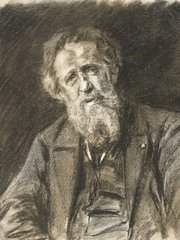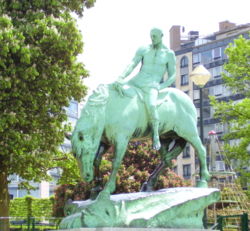
Constantin Meunier
Encyclopedia


Belgium
Belgium , officially the Kingdom of Belgium, is a federal state in Western Europe. It is a founding member of the European Union and hosts the EU's headquarters, and those of several other major international organisations such as NATO.Belgium is also a member of, or affiliated to, many...
painter
Painting
Painting is the practice of applying paint, pigment, color or other medium to a surface . The application of the medium is commonly applied to the base with a brush but other objects can be used. In art, the term painting describes both the act and the result of the action. However, painting is...
and sculptor
Sculpture
Sculpture is three-dimensional artwork created by shaping or combining hard materials—typically stone such as marble—or metal, glass, or wood. Softer materials can also be used, such as clay, textiles, plastics, polymers and softer metals...
, was born in Etterbeek
Etterbeek
Etterbeek is one of the nineteen municipalities located in the Brussels-Capital Region of Belgium. It neighbours the municipalities of the City of Brussels, Ixelles, Auderghem, Woluwe-Saint-Pierre, Woluwe-Saint-Lambert and Schaerbeek....
, Brussels
Brussels
Brussels , officially the Brussels Region or Brussels-Capital Region , is the capital of Belgium and the de facto capital of the European Union...
.
His first exhibit was a plaster sketch, "The Garland," shown at the Brussels Salon in 1851. Soon afterwards, on the advice of the painter Charles de Groux, he abandoned the chisel for the brush. His first important painting, "The Salle St Roch" (1857), was followed by a series of paintings including "A Trappist Funeral" (1860), "Trappists Ploughing" (1863), in collaboration with Alfred Verwee, "Divine Service at the Monastery of La Trappe" (1871) and episodes of the German Peasants' War
German Peasants' War
The German Peasants' War or Great Peasants' Revolt was a widespread popular revolt in the German-speaking areas of Central Europe, 1524–1526. At its height in the spring and summer of 1525, the conflict involved an estimated 300,000 peasants: contemporary estimates put the dead at 100,000...
(1878).
About 1880 he was commissioned to illustrate those parts of Camille Lemonnier
Camille Lemonnier
Antoine Louis Camille Lemonnier was a Belgian writer, poet and journalist. He was a member of the Symbolist La Jeune Belgique group, but his best known works are realist. His first work was Salon de Bruxelles , a collection of art criticism...
's description of Belgium in Le Tour du monde which referred to miners and factory-workers, and produced "In the Factory," "Smithery at Cockerill's," "Melting Steel at the Factory at Seraing" (1882), "Returning from the Pit," and "The Broken Crucible" (1884).
In 1882 he was employed by the government to copy Pedro de Campaña's "Descent from the Cross" at Seville
Seville
Seville is the artistic, historic, cultural, and financial capital of southern Spain. It is the capital of the autonomous community of Andalusia and of the province of Seville. It is situated on the plain of the River Guadalquivir, with an average elevation of above sea level...
, and in Spain he painted such characteristic pictures as "The Café Concert," "Procession on Good Friday," and "The Tobacco Factory at Seville" (Brussels Gallery). On his return to Belgium he was appointed professor at the Louvain Academy of Fine Arts.
In 1885 he returned to statuary and produced " The Puddler," "The Hammerer" (1886), "Firedamp" (1889, Brussels Gallery), "Ecce Homo
Ecce Homo
Ecce Homo are the Latin words used by Pontius Pilate in the Vulgate translation of the , when he presents a scourged Jesus Christ, bound and crowned with thorns, to a hostile crowd shortly before his Crucifixion. The original Greek is Ἰδοὺ ὁ ἄνθρωπος . The King James Version translates the phrase...
" (1891), "The Old Mine-Horse" (1891), "The Mower" (1892), "The Glebe" (1892), the monument to Father Damien
Father Damien
Father Damien or Saint Damien of Molokai, SS.CC. , born Jozef De Veuster, was a Roman Catholic priest from Belgium and member of the Congregation of the Sacred Hearts of Jesus and Mary, a missionary religious order...
at Louvain (1893), "Puddler at the Furnace" (1893), the scheme of decoration for the Botanical Garden of Brussels
Botanical Garden of Brussels
The Botanical Garden of Brussels stands on Rue Royale, near the Northern Quarter financial district in Brussels.Originally founded in 1826 and partly designed by architect Tilman-François Suys, the main orangery is composed of a central rotunda with a dome, and two side aisles with windows at the...
in collaboration with the sculptor Charles van der Stappen
Charles van der Stappen
Charles van der Stappen , was a Belgian sculptor, born in Saint-Josse-ten-Noode.- Life :Educated at the Académie Royale des Beaux-Arts in Brussels , van der Stappen's contribution to the Brussels Salon was "The Faun's Toilet" of 1869, and thereafter he began to produce work of a high and novel...
(1893), "The Horse at the Pond," in the square in the north-east quarter of Brussels, and two unfinished works, the "Monument to Labour" and the Zola
Émile Zola
Émile François Zola was a French writer, the most important exemplar of the literary school of naturalism and an important contributor to the development of theatrical naturalism...
monument, in collaboration with the French sculptor Alexandre Charpentier
Alexandre Charpentier
Alexandre-Louis-Marie Charpentier was a French sculptor, medalist, craftsman, and cabinet-maker. From working-class origins and apprenticed to an engraver as a young man, he became a studio assistant to the innovative medallist Joseph-Hubert Ponscarme...
.
The "Monument to Labour," which was acquired by the State for the Brussels Gallery, comprises four stone bas-reliefs, "Industry," "The Mine," "Harvest," and the "Harbour"; four bronze statues, "The Sower" "The Smith" "The Miner," and the "Ancestor"; and a bronze group, "Maternity".
Meunier died at Brussels on 4 April 1905. Constantin Meunier was a freemason, and a member of the lodge Les Amis Philanthropes of the Grand Orient of Belgium
Grand Orient of Belgium
The Grand Orient of Belgium The Grand Orient of Belgium The Grand Orient of Belgium (French: Grand Orient de Belgique, Dutch: Grootoosten van Belgie (G.O.B.) is a Belgian cupola of masonic lodges which is only accessible for men, and works in the basic three symbolic degrees of freemasonry.-History:...
in Brussels. He was one of the cofounders of the Société Libre des Beaux-Arts
Société Libre des Beaux-Arts
The Société Libre des Beaux-Arts was an organization formed in 1868 by Belgian artists to react against academicism and to advance Realist painting and artistic freedom. Based in Brussels, the society was active until 1876, by which time the aesthetic values it espoused had infiltrated the...
of Brussels.
In 1939, a museum dedicated to him was opened in the last house in which Meunier lived and worked, in Ixelles. Today about 150 of his works are displayed there.
External links
- Works of Constantin Meunier at the Museum of Modern Art, Brussels
- The Constantin Meunier Museum, Brussels
----

